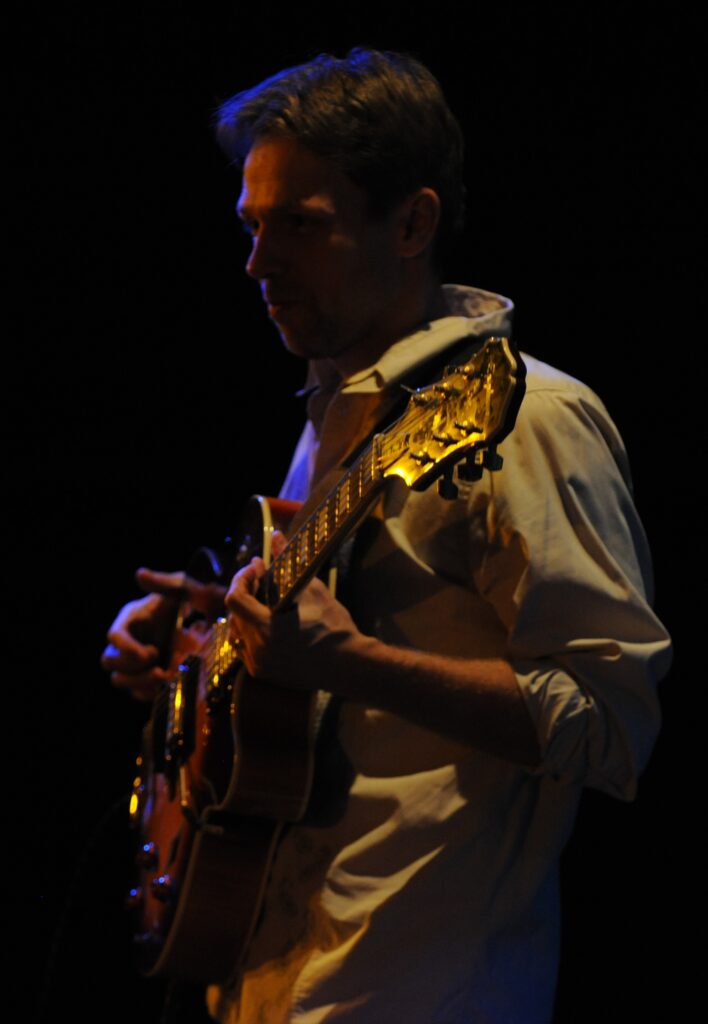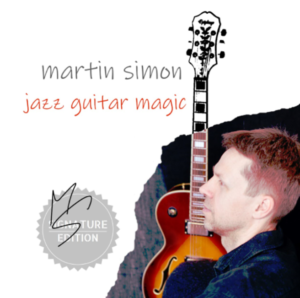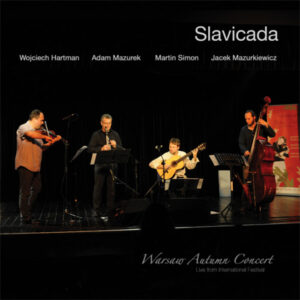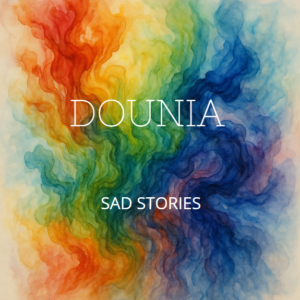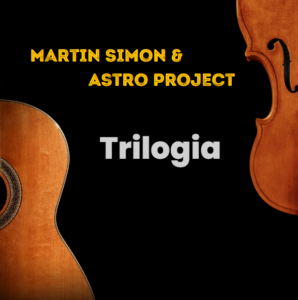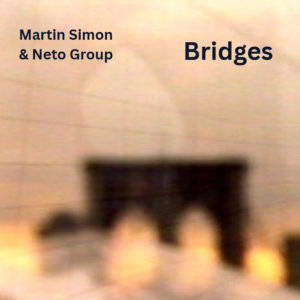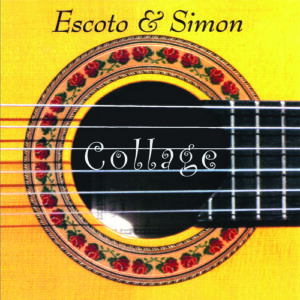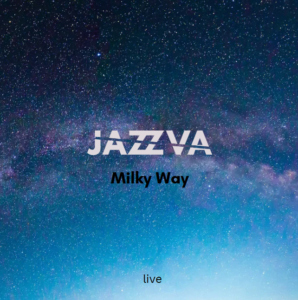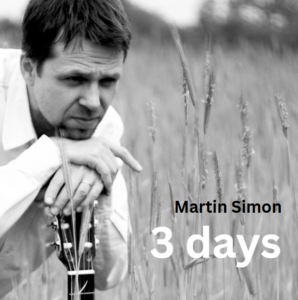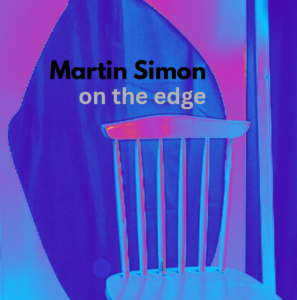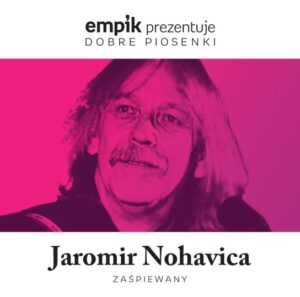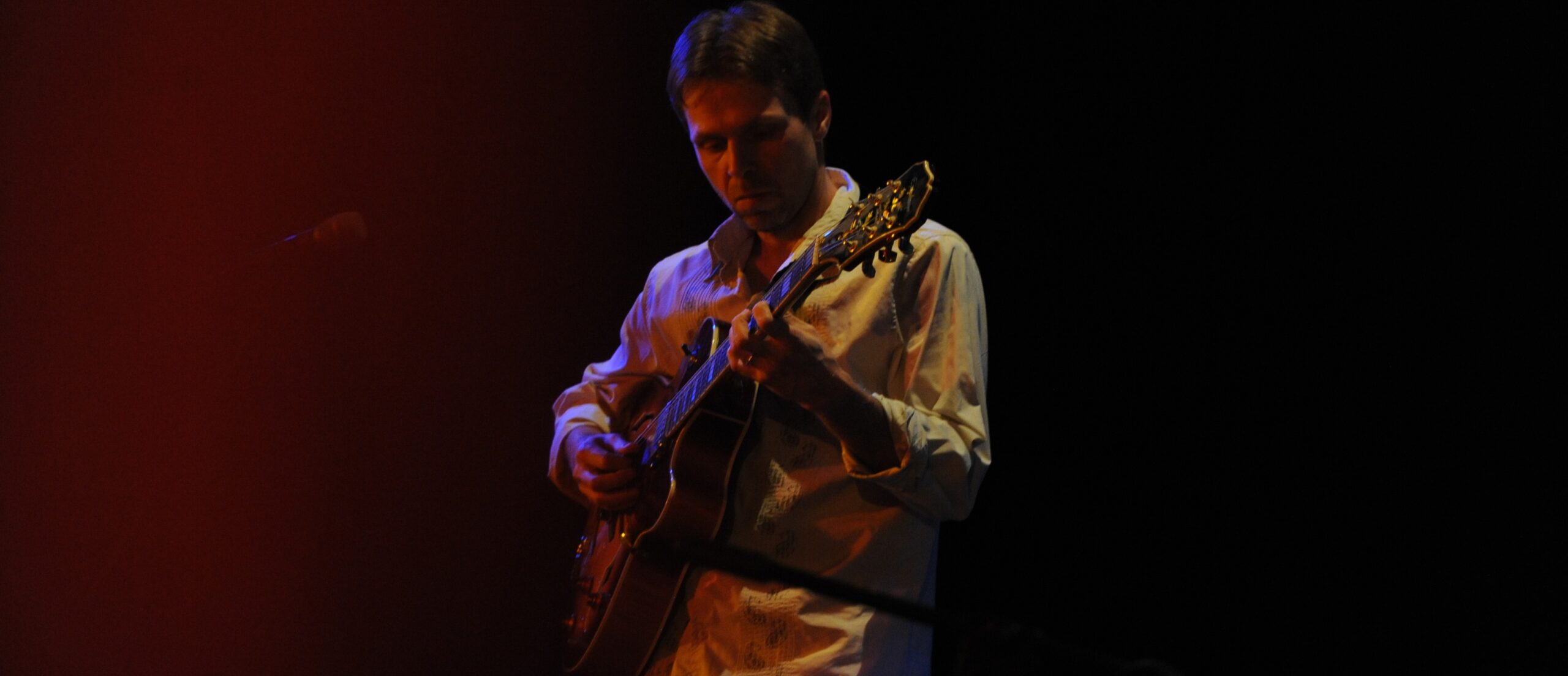
Martin Simon
Composer & Guitarist
One of the more adventurous creators to emerge from Slovakia, Martin Simon (Martin Šimon in Slovak) crafts a sound that bridges his Central European roots with jazz and playful experimentation. His music is a vivid dialogue between tradition and innovation, where imagination, composition and spontaneity converge in resonant ways.
His early musical journey was shaped by listening to Dire Straits, Pat Metheny Group, Weather Report, Oregon and Mahavishnu Orchestra, as well as Bach, Stravinsky, Ravel, Debussy and Piazzolla to name a few. These influences helped shape his artistic sensibility, yet his own voice—harmonically rich and emotionally intensive—has emerged as something unmistakably his own.
He has worked with artists from Europe, North and Latin America, Asia and Africa. He also holds a master of music degree and was an academic instructor in New York City.
Martin’s story…
- Click here to read more -
Growing up in Bratislava, at the crossroads of Vienna, Prague, and Budapest, Martin started playing classical guitar at age 10. As a teenager, inspired by his older brother, who played saxophone in a high school band, he also embraced the electric guitar. While simultaneously playing soccer in the national junior league, he tried to find as much time with the guitar as he could. Eventually, he left soccer behind and devoted more time to music.
He took lessons from classical guitarists Daniela Kukumbergova and František Grof, where he was fortunate to find a vibrant community of like-minded, passionate young guitarists, who would never leave the corridor in front of the classroom, occupying every available bench or the staircase—always playing, exchanging ideas and inspiring one another—a great way to discover new repertoire and build bonds.
Eager to explore the world of jazz, he began attending jazz concerts and workshops where he met his jazz mentors like Matúš Jakabčic, Stanislav Počaji, and Brazilian guitarist Fernando Correa, who was based in Austria. He borrowed dozens of LPs from his much older cousin, an avid jazz listener whose vast collection included Charley Parker, Gerry Mulligan, John Coltrane, Miles Davis and many more, while he tried attending every possible jazz concert in the city.
One of the most profoundly influential moments was meeting Brazilian guitarist Toninho Horta around 1995 in his hometown, Bratislava, following a performance with Austrian violinist Rudi Berger and one of the godfathers of Slovak jazz, drummer and percussionist Dodo Šošoka.
He was so enthralled by the music that Šošoka generously offered to copy all of Toninho’s albums onto magnetic tapes—a rare gift in a time when such recordings were nearly impossible to find in physical stores or prohibitively expensive (not to mention, internet music stores didn’t exist yet). Every now and then, Šošoka would invite Martin to his home, handing him a new recording to absorb. This friendly relationship deepened Martin’s passion for jazz, shaped by the open spirit and generosity.
During this time, Martin did not pursue formal music education, as he faced conflicting family expectations and a lack of support for a career in music. Undeterred, he carved his own path—visiting the public library, borrowing books on harmony, orchestration, and music theory, and practicing ear training on his own. He also informally attended jazz classes at the city’s music conservatory, along with university lectures in the musicology department, all while training his voice as part of the Lúčnica choir whenever time allowed. He worked student jobs and played guitar on the streets of Vienna’s historic center to save money for an instrument and equipment, as the discrepancies in prices between Eastern and Western European borders were staggering.
Martin’s sensibility and talent for creativity was recognized in his early 20s when he became the laureate of the New Faces of Slovak Jazz award for original compositions with his first jazz-rock fusion group Jazzva—a milestone that marked the beginning of his remarkable journey.
Despite the lack of formal schooling and financial resources, his dedication to expanding his musical horizons led him to New York, where he was accepted into the master’s composition program at Brooklyn College under the guidance of composer and conductor Tania León.
With the support of a travel grant and the faculty directors, he was able to secure the visa that had initially been denied, allowing him to move to New York and immerse himself in the city’s dynamic creative scene. There, he honed his craft through training in composition, performance, and interactive media arts.
His mentors included pioneering and avant-garde artists from around the world—professors and/or alumni of Juilliard, Princeton, Harvard, Stanford, and others—including Noah Creshevsky, Douglas Cohen, George Brunner, Salim Washington, Amnon Wolman, Miroslaw Rogala, and John J.A. Jannone—each shaping his artistic vision while encouraging fearless experimentation.
Throughout his time in New York, Martin collaborated with artists from diverse backgrounds, further enriching his sonic palette. On NYC’s Music Row, along the legendary 48th Street, he met his fellow guitarist Astor Escoto—a Spanish-Honduran classical and flamenco composer—with whom he formed the Escoto & Simon guitar duo. He supported himself by playing in Manhattan clubs, where he encountered a wide array of Latin American artists, from Peru through Venezuela and Colombia all the way to Mexico, as well as New York’s flamenco community, which felt like a second family of kind-hearted souls who supported him when he had nothing but a suitcase. He even learned to sing Brazilian Portuguese phonetically, to the point where his Brazilian friends would continue speaking to him in Portuguese, forgetting he didn’t understand a word.
As a student, he also supported himself as a street artist, drawing portraits in Central Park and Times Square—a skill he picked up by accident while living with a painter from Macedonia, a sculptor from Colorado, and spending time with a group of Chinese charcoal artists. Time Out New York magazine featured him on its inside front cover alongside a spotlight article.
His musical projects brought him into collaboration with artists from across the globe—from Asia through New Zealand and Africa, all the way to North and Latin America—including David Watson (John Zorn), Paul Steven Ray (Vernon Reid, Cyro Baptista), Salim Washington (Kenny Garrett, Anthony Braxton), Chris Bacas (Buddy Rich), Jorge Amorim (Baden Powell, Al Foster), Bobby Rozario (Zakir Husain), Arturo Martinez (José Greco), Alfonso Cid (Pilar Rioja, Romeo Santos), Peter Basil Bogdanos (Carlota Santana, Noche Flamenca), Alí Bello (Tito Puente, Eddie Palmieri, Beyoncé), Pedro Ramos (Choro Ensemble, Wynton Marsalis), Scott Kettner (Willie Nelson, Klezmatics), Neil Ochoa (David Byrne), Carlos Hayre, Elizabeth Whalley, David Reeder, Noums Dembele, Ernie Shaeffer, and many more.
One of his collaborations with Israeli filmmaker Anat Inbar led to Hollywood’s Beverly Hills for an award ceremony hosted by HBO, while another—with South Korean film director Soung Hee Ann—resulted in a Critics’ Week Award at Cannes.
Thanks to his Polish-born wife, Martin found a way to reconnect with his Central European roots, meeting many outstanding Polish musicians. He became involved in the Visegrad V4 projects, which bring together artists from Hungary, the Czech Republic, Slovakia, and Poland.
Martin has performed with Polish accordionist Robert Kuśmierski, known for his work with Czech folk legend Jaromír Nohavica, and recorded instrumental parts for several of Nohavica’s songs released under a Polish label. He’s also had the chance to jam with Polish jazz icons such as Michał Urbaniak, Wojciech Karolak, and Henryk Miśkiewicz, along with many other outstanding musicians from classical, jazz, and world music scenes.
As he puts it: “I’m deeply grateful to everyone on my journey for the trust I’ve been given along the way, and the opportunity to make art and music a real possibility. I want to give back as much as I’ve received from all those kind and generous people.”
True to this spirit, Martin has been active as an educator from the very beginning. At 22, he spent a year as a substitute classical guitar teacher at a music school in Bratislava. In New York, after countless sleepless nights in the campus studio lab—often accidentally locked in by security guards—Martin was offered a job at the university while still a student. Shortly after graduating, he became the youngest faculty member at Pratt Institute in New York, where he was appointed assistant professor of music and studio production for animation, film, and digital media. He also runs his own guitar school, mentoring the next generation of guitarists.
Martin is the originator of the conversational music concept, which he has developed, presented, and recorded in collaboration with various artists. Through his exploration of pioneering concepts in modern avant-garde composition, Martin has developed a distinctive approach to writing music based on what he calls movable parts. He was invited as a guest of the International Society for Improvised Music (ISIM), where he appeared alongside artists such as Pauline Oliveros, Oliver Lake, Art Lande, Mazen Kerbaj, Stephen Nachmanovitch, Michael Zerang, Anto Pett, Mark Dresser, Jane Ira Bloom, and members of the AACM. Martin’s experimental work has been published by University Press of America.
Today Martin stands at the crossroads of tradition and innovation, weaving his Central European roots into jazz, world music, and contemporary soundscapes. His performances are an electrifying fusion of compositions that possess melodic, rhythmic and harmonic depth, emotional resonance, filled with spontaneous improvisations—driven by joy and impulse of the moment. His guitar style remains deeply personal—marked by a bursting, free-flowing, lyrical aesthetic that fuses classical and electric guitar sounds.
Live shows
Energofuzia
Martin’s latest works blend modern jazz with vibrant traditional Central European influences in a bold, high-energy performance.
After nearly a decade in New York, Simon brings a fresh, globally informed perspective to his roots.
Backed by outstanding musicians, Energofuzia delivers music that is spontaneous, emotional, and full of surprises. A unique fusion of tradition, improvisation, and modern sound—this is jazz reimagined through a Central European lens.
Slavicada
“Where Central European folk meets jazz and classical music”
In the video: Adam Mazurek, Wojciech Hartman, Jacek Mazurkiewicz, Martin Simon
Astro Latin
“Latin originals & classics”
In the video: Paweł Mazurczak, Adam Rozenman, Martin Simon
Dounia
“The Power of Sad Stories”
Wojciech Madajski – fretless bass, Martin Simon – guitar
Escoto & Simon
“New York City flamenco vibes”
In the video: Alfonso Cid, Gosia Simon, Carlos Revollar, Astor Escoto, Martin Simon
Featured albums
Listen to a sample track
Martin’s Suita Slavicada with an acoustic quartet live
Listen to a sample track
Evocative musical storytelling driven by melodic lines on fretless bass and guitar.
Listen to a sample track
Flamenco/Latin jazz/classical trilogy arranged for instruments and voice
Listen to a sample track
Latin/jazz/rock/orchestral journey from New York to Brazil, Argentina and France
Listen to a sample track
Original works for classical and acoustic guitar
Listen to a sample track
Martin’s early jazz-rock fusion works (live concert)
Listen to a sample track
Acoustic guitar trilogy with voice
Listen to a sample track
Highly avant-garde and exploratory works
Warning: Not recommended for the unprepared or untrained ear
Listen to a sample track
Some of Martin’s classical guitar accompaniments
Compilation of songs by a Czech folk legend, interpreted by Polish artists.
Listen to a sample track
Press
Art of leaving listeners spellbound. Rarely does jazz music ever dazzle with such subtle artistry and fragile emotions. It will haunt your days.
Jazz Corner
This is no pointless exercise in showmanship. Each tune seems to tell a story.
All About Jazz
Timeless, brain-massaging, thought-provoking collection of airy musical ruminations with world-class production.
Music Zeitgeist
An emotional range like that is very impressive and should be commended. Collage might very well be one of the best contemporary world guitar albums of the decade.
Muzik Reviews
Each part blends together with such grace and eloquence, assembling not only myriad inspirations but separate ideas in a compelling whole.
All About Jazz
Identity is an endlessly variable sort of thing, so why shouldn’t our national ditty occasionally stretch its wings too? Being here has given one the freedom to play with some themes one might have otherwise considered sacred.
Globe and Mail
A music that refuses to stand still, is reaching for future horizons, and cannot be pigeonholed.
Jazz Review
Their talents are not only breathtaking but one can hear how well they hypnotically bond together.
Radio Indy
A wonderful music with a wide range of modern classical guitar, as expressed through Spanish and Latin phrasings and rhythms, where guitar continues to be used gracefully and wonderfully into an unforeseeable future.
The Classical Guitarist
Hudobne predstavuje táto skupina unikátny experiment na poli sonoristiky. V kompozícii sa kladie dôraz na atmosféru a náladu, kompozičný zámer autora v zmysle postihnutia obsahovosti.
Infojazz
Výsledná hudobná symbióza je až hypnotickou poéziou bez samoúčelných exhibícií. Robí ho zaujímavým aj bohatstvo hudobných kontrastov, keď sa výbuchy radosti striedajú s mimoriadne tmavými, nostalgickými plochami.
Hudobný život
Na powrót do źródeł czekaliśmy od dawna i nareszcie za sprawą tego projektu przeniesiemy w czasowo i geograficznie inny wymiar. Zespół swoim świeżym podejściem na nowo łączy korzenie tradycji z nowoczesnością. Ich muzyka jest śmiała i niebanalna.
Pardon To Tu
Contact
For any inquiries, feel free to email: martinsimoncontact@gmail.com
